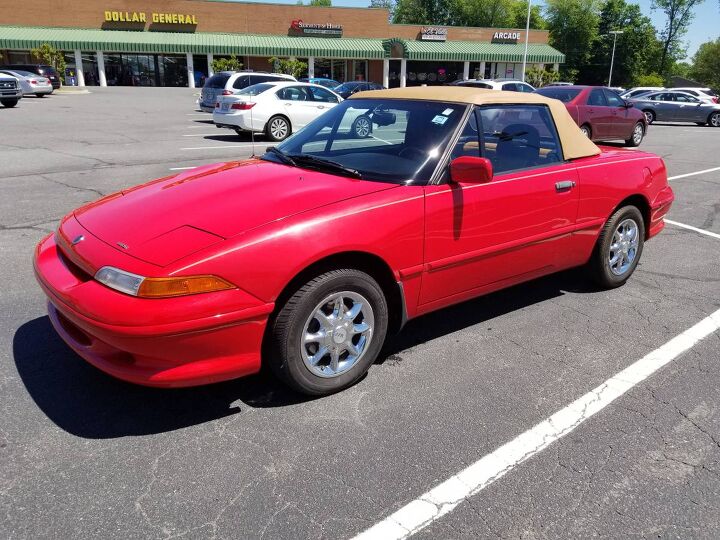Rare Rides: The 1994 Mercury Capri - Miata's Serious Competitor

The Rare Rides series has featured two Capri-adjacent vehicles in past: This car’s immediate predecessor, the ASC McLaren Capri, and its contemporary competitor, the Lotus Elan. Let’s find out how much better the final Capri was than either of those two (or not).
The era of the rear-drive Capri as Mustang sibling ended after the 1986 model year, when it was cancelled due to a distinct lack of buyer interest. The Cougar lived on, carrying Mercury’s performance car flag alone, albeit under the cover of a personal luxury blazer. However, as the Nineties dawned, the performance roadster segment was heating up quickly. Mazda introduced its new Miata for 1990, faithfully blending the old British roadster recipe with a helping of reliability.
Not to be outdone by Japan, Lotus got in on the new roadster hotness with its M100 Elan. Ford wished to compete with cars like the Mazda and Lotus, too, so it placed a call to those ultimate roadster aficionados — Australians — and also to Mazda.
Mercury’s new Capri went on sale in 1991, derived from one of Ford’s favorite Nineties platforms: the Mazda BG. From that platform sprang the 323, the Australian-market Ford Laser, the American-market Ford Escort, the Capri, and later the Kia Sephia.
The Capri was a unique offering on North American Lincoln-Mercury lots; there was no Ford sibling to be had anywhere (a first for the two brands since 1978). Built in Victoria, Australia, the Ford Capri was turned into a Mercury via some new gauges, airbags, and body-colored bumpers. Like the Lotus, it was a front-drive affair, and like the Mazda it was available with a removable hard top. Since it was similar to the Mazda 323, it was sold with that car’s 1.6-liter inline-four engine, in either standard (100 hp) or upmarket XR2 turbocharged (132 hp) guise. A four-speed automatic or five-speed manual sent power to the front wheels of the 166-inch long cabriolet. XR2 models benefited from an independent rear suspension and more beefy sway bars front and rear.
From 1991 to 1993, the Capri remained unchanged, though it received some visual upgrades for 1994. New, more prominent bumpers meant overall length increased by a full inch. There were also new tail lamps. All these features were available a year earlier on Australian-market Capris.
Ford knew its audience, pricing the Capri just like the Miata; both cars were much less expensive than the Isuzu-powered Lotus Elan. But it didn’t make much of a difference, as evidenced by flagging sales figures. The Capri was cancelled without a successor for 1994, and Mercury never again offered a convertible or any vehicles bearing the Capri name.
Today’s Rare Ride is a clean example from 1994, sporting rarely seen front and rear refreshed visuals. With aftermarket leather seat covers, EPIC-ally bad chrome wheels, and 80,000 miles on the odometer, it asks a reasonable $2,800.
[Images: seller]

Interested in lots of cars and their various historical contexts. Started writing articles for TTAC in late 2016, when my first posts were QOTDs. From there I started a few new series like Rare Rides, Buy/Drive/Burn, Abandoned History, and most recently Rare Rides Icons. Operating from a home base in Cincinnati, Ohio, a relative auto journalist dead zone. Many of my articles are prompted by something I'll see on social media that sparks my interest and causes me to research. Finding articles and information from the early days of the internet and beyond that covers the little details lost to time: trim packages, color and wheel choices, interior fabrics. Beyond those, I'm fascinated by automotive industry experiments, both failures and successes. Lately I've taken an interest in AI, and generating "what if" type images for car models long dead. Reincarnating a modern Toyota Paseo, Lincoln Mark IX, or Isuzu Trooper through a text prompt is fun. Fun to post them on Twitter too, and watch people overreact. To that end, the social media I use most is Twitter, @CoreyLewis86. I also contribute pieces for Forbes Wheels and Forbes Home.
More by Corey Lewis
Latest Car Reviews
Read moreLatest Product Reviews
Read moreRecent Comments
- Analoggrotto What the heck are those people doing in front of that house? Just staring at this stupid pos truck?
- Jeff Good review but the XLT although not a luxury interior is still a nice place to be. The seats are comfortable and there is plenty of headroom. The main downside is the limited availability resulting in dealer markups above MSRP. I have a 2022 hybrid Maverick XLT for over 2 years and it has more than met my expectations. I believe for many who do not need a truck most of the time but want one the Maverick will meet their needs.
- Kwik_Shift_Pro4X I use a now discontinued Kuhmo AT tire that is surprisingly good in the snow, even in 2WD. However since most of my driving is on road, I'm going to look for a more highway friendly tire for smoother quiet. I'm sure it can still handle the forest roads leading to my fishing spots.
- MaintenanceCosts So this is really just a restyled VW Fox. Craptacular tin can but fun to drive in a "makes ordinary traffic seem like a NASCAR race" kind of way.
- THX1136 While reading the article a thought crossed my mind. Does Mexico have a fairly good charging infrastructure in place? Knowing that it is a bit poorer economy than the US relatively speaking, that thought along with who's buying came to mind.






































Comments
Join the conversation
I worked at a Lincoln Mercury dealer while these were still being sold. All the knocks on it are accurate, however the XR2 with the 1.6 turbo would walk away from a Miata all day. It was quick.
Or you go over to the Dollar General in the background and buy 2800 items.